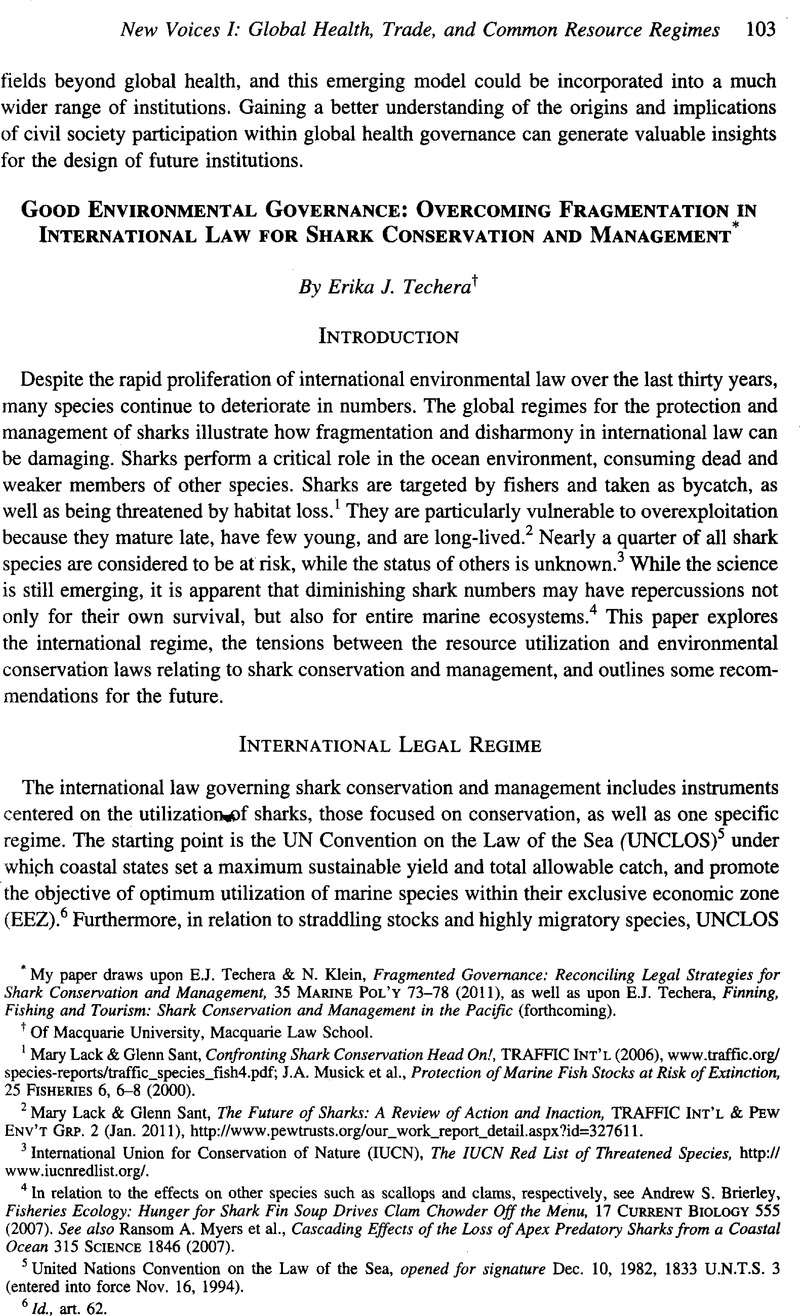No CrossRef data available.
Published online by Cambridge University Press: 28 February 2017

1 Lack, Mary & Sant, Glenn, Confronting Shark Conservation Head On!, Traffic Int’l (2006)Google Scholar, www.traffic.org/species-reports/traffic_species_fish4.pdf; Musick, J.A. et al., Protection of Marine Fish Stocks at Risk of Extinction, 25 Fisheries 6, 6-8 (2000)Google Scholar.
2 Lack, Mary & Sant, Glenn, The Future of Sharks: A Review of Action and Inaction, Traffic Int’l & Pew Env’t Grp. 2 (Jan. 2011)Google Scholar, http://www.pewtmsts.org/our_work_report_detail.aspx7icb327611.
3 International Union for Conservation of Nature (IUCN), The IUCN Red List of Threatened Species, http://www.iucnredlist.org/.
4 In relation to the effects on other species such as scallops and clams, respectively, see Brierley, Andrew S., Fisheries Ecology: Hunger for Shark Fin Soup Drives Clam Chowder off the Menu, 17 Current Biology 555 (2007)CrossRefGoogle Scholar. See also Myers, Ransom A. et al., Cascading Effects of the Loss of Apex Predatory Sharks from a Coastal Ocean 315 Science 1846 (2007)CrossRefGoogle Scholar.
5 United Nations Convention on the Law of the Sea, opened for signature Dec. 10, 1982, 1833 U.N.T.S. 3 (entered into force Nov. 16, 1994).
6 Id., art. 62.
7 Id., arts. 63, 64.
8 UN Agreement for the Implementation of the Provisions of the United Nations Convention on the Law of the Sea of 10 December 1982 Relating to the Conservation and Management of Straddling Fish Stocks and Highly Migratory Fish Stocks, opened for signature Dec. 5, 1995, 34 ILM 1542 (entered into force Dec. 11, 2001).
9 For example, the International Commission for the Conservation of Atlantic Tuna (ICCAT), the Northwest Atlantic Fisheries Organization (NAFO), and the Western and Central Pacific Fisheries Commission (WCPFC).
10 Lack, Mary & Sant, Glenn, Illegal, Unreported and Unregulated Shark Catch: A Review of Current Knowledge and Action. Traffic Int’l (Apr. 2008)Google Scholar, www.traffic.org/species-reports/traffic_species_fish30.pdf.
11 Convention on International Trade in Endangered Species of Wild Fauna and Flora (CITES), opened for signature Mar. 3, 1973, 993 U.N.T.S. 243 (entered into force July 1, 1975).
12 Id., art. 11(3).
13 The species proposed for listing were: porbeagle shark, white-tipped sharks, scalloped hammerheads, the great hammerhead, the smooth hammerhead, spiny dogfish, the sandbar shark, and the dusky shark.
14 Convention on the Conservation of Migratory Species of Wild Animals, opened for signature June 23, 1979, 1651 U.N.T.S. 356 (entered into force Nov. 1, 1983).
15 Id., art. I, para 1(e); art. Ш, para 2. “Range states” include those that exercise jurisdiction over any part of the range, as well as states registering vessels that take migratory species on the high seas. Id., art. I(l)(h).
16 Id., arts. Iv(3), V.
17 Memorandum of Understanding on the Conservation of Migratory Sharks, http://www.cms.int/species/sharks/MoU/Migratory_Shark_MoU_Eng.pdf. For an overview of the final negotiations and adoption of the Mou, see C. Chiarolla, D. Nyingi & M. Sommerville, Summary of the Technical Meeting for the Elaboration of a Conservation and Management Plan for Migratory Sharks and the Third Meeting on International Cooperation on Migratory Sharks Under the Convention on Migratory Species and Wild Animals: 8-12 February 2010, at 18 Earth Negotiations Bull. (2010), <www.iisd.ca/cms/sharks3/>.
18 The Mou only applies to the sharks listed in Appendices I and II of the Cms.
19 The Mou has been signed by 14 states including, most recently, Australia.
20 Convention on Biological Diversity, art 8, opened for signature June 5, 1992, 1760 U.N.T.S. 79 (entered into force Dec. 29, 1993).
21 IPOA-Sharks, para. 4.
22 IPOA-Sharks, Appendices A and B, respectively. See also IPOA-Sharks, para. 22.
23 Only 13 of the top 20 shark fishing nations have developed plans. Lack & Sant, supra note 2.
24 Id.
25 See that action taken in Chile and the United States (including the Commonwealth of the Northern Mariana Islands, Guam, and the state of Hawaii, with Washington, Oregon and California also considering bans). The EU has adopted a 5% fin to body weight ratio, which has also been adopted by some RFMOs.
26 The Maldives banned the harvesting of all reef sharks and subsequently placed a twelve-month moratorium on catching any shark species. A similar moratorium was invoked by Honduras in 2010. Tre’ Packard, Movers and Shakers: Global Action to Protect Sharks (11 March 2011), Journal Online, <http://www.journal.com.ph/index.php/news/environment/814-movers-a-shakers-global-action-to-protect-sharks>.
27 Palau declared the first shark sanctuary in 2009, followed by Indonesia in 2010. Most recently, Costa Rica has followed this trend, with an executive decree in relation to the Cocos Islands. Massive New Marine Protected Area Offers Oasis and Hopefor Endangered Sharb and Sea Turtles, Conservation Int’l, <http://www.conservation.org/newsroom/pressreleases/Pages/New_Cocos_Marine_Protected_Area.aspx>.
28 E.g., IPOA-Sharks, para. 16; Cms Mou, § 3; 1995 Fish Stocks Agreement, art. 6. Herndon, A. et al., The Case for an International Commission for the Conservation and Management of Sharks (ICCMS), 34 Marine Pol’y 1239–8 (2010)Google Scholar.
30 FAO, Code of Conduct for Responsible Fisheries, available at <http://www.fao.org/docrep/005/v9878e/v9878e00.HTM>.
31 Agreement to Promote Compliance with International Conservation and Management Measures by Fishing Vessels on the High Seas, <http://www.fao.org/legal/treaties/012t-e.htm> (last visited July 2, 2010).
32 Model Scheme on Port Measures to Combat Illegal, Unreported and Unregulated Fishing, available at <http://www.fao.org/docrep/010/a0985t/a0985t00.htm>.
33 Fao Fishstat Capture Production Database, <http://www.fao.org/fishery/statistics/software/fishstat/en>.
34 Lack & Sant have discovered that only 20% of shark catch data reported to the Fao is on a species basis. The data that are available often simply indicate the gross shark catch in tonnages, which is of limited informational value in designing regulatory tools to conserve and manage individual species. See, for example, Fao Yearbook 2006, Fishery and Aquaculture Statistics, which reports under one category “sharks, rays and chimaeras.”